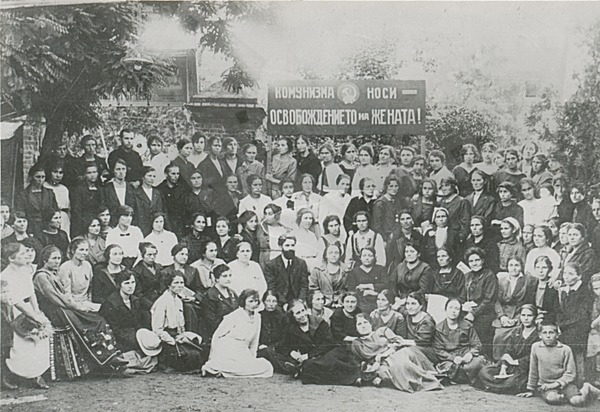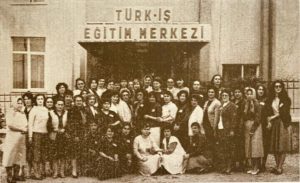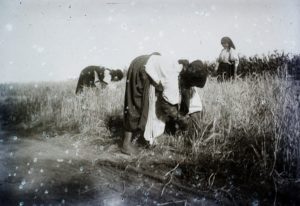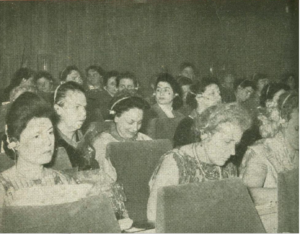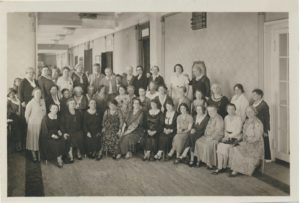by Ivelina Masheva
Thinking about women’s labour activism from a transnational perspective usually evokes associations with international organizations’ structures, the formal congresses they organized and the key documents that they adopted. This widely covered and publicly visible side of international activism however was preceded, followed and in fact made possible by mundane, day-to-day forms of activism such as data collection, generating drafts, instructions and reports, translation and courier services in which women often played a very prominent role.[1] In this blog post, I focus on this perhaps less glamorous but undoubtedly crucial aspect of women labour activists’ transnational networking through the case study of the correspondence between the Women’s Commission of the Central Committee of Bulgarian Communist Party and the International Women’s Secretariat of the Comintern[2] in the early 1920s.[3]
In a previous blog post, I have mentioned Ana Maimunkova’s[4] participation in the Second International Communist Women’s Congress in Moscow in 1921. Here, I would like to follow this entanglement between the local, national and international activities of left-wing women activists by focusing on the aftermath of the 1921 Congress. Investigating the enduring ties within the transnational communist movement in the context of day-to-day activism gives illuminating insights on how international cooperation and transnational networks related to and impacted women’s labour activism in a local and national context.
One of the first and most easily recognizable consequences of transnational entanglements was the formation of sustainable solidaristic networks with a deep motivational, inspirational and (self-) disciplining potential. Requests to draw reports, transmit news and send updates gave local activists the impetus to initiate and broaden the scope of their campaigns, motivated them to put additional efforts in order to report better results and gave them feedback on how they “measured up” to their peers abroad. Upon receiving praise and validation of their efforts after reporting the success of the May Day campaign in 1922 – a campaign which drew more than 40 000 women to attend the countrywide demonstrations – Bulgarian women communists admitted that “we are deeply moved by the praises of our activity, we confess that we do not feel that we live up to them and will try to justify them with all our strength and means.”[5]
Second, international cooperation had a converging and cross-fertilization effect, resulting in travel and translation of agendas, repertoires, and organizational forms from the international to the national and local level and vice versa. As our previous blog post has convincingly shown with regard to the 1931 International Socialist Women’s Conference in this process East European women brought their specific demands and local knowledge. In this regard, it is important to take into account that due to the Soviet Union’s special position in interwar transnational communism, the Comintern and its affiliated organizations constituted a peculiar type of organization – one that did not fit neatly in the category of multilateral state organizations or in that of international non-governmental organizations.[6] The solidaristic and centralizing potential of transnational communism was often exploited by and subjugated to Soviet foreign policy, which can be illustrated by Bulgarian communist women’s enthusiastic participation in the campaign to help victims of the 1921-1922 Russian famine and the adoption of the demand to stop the “economic and political war against Soviet Russia” as key points in their agenda.
While it can’t be denied that the Bolsheviks used the Comintern and its affiliated organizations as foreign policy tools, it is worth looking beyond this well-exploited trope. Communist solidarity networks can also be considered as predecessors to contemporary international NGOs in their role as “conscience of the world”.[7] Communist women attempted with joint efforts to solve working women’s common socio-economic problems in post-World War I Europe, such as unaffordable pricing of basic necessities, high taxation, unemployment, insufficient protection of maternity and childhood. In this regard Comintern’s clearly hierarchical structure and its emphasis on discipline and compliance with the party line, while not excluding the possibility of bottom-up initiatives, was particularly conducive to the top-down transfer of ideology, tactics, and strategy. The converging impact of transnational cooperation is clearly visible in communist women’s choice of repertoires with coordinated campaigns around International Women’s Day being the most visible and recognizable manifestation. The travel and translation of repertoires sometimes took on a quite literal meaning as local activists translated, published and popularized works of prominent international activists. Thus, in 1922 Clara Zetkin’s book on the communist women movement and her theses on work among women were translated to Bulgarian, published and distributed to communist women’s commissions around the country with the instruction to use them as key agitation materials in the 8 March campaign in 1922.[8]
Finally, when discussing internationalism’s impact on nationwide and local activism it is important to emphasize the added value that women activists in particular drew from their involvement in activism on an international scale. Women activists often turned into an asset the prestige of the international plane and used their international involvement as leverage to compensate for their marginalized domestic position. The issue of Bulgarian women workers’ inclusion into the communist-affiliated trade unions offers a particularly illuminating example. On 1 August 1922 Ana Maimukova, on behalf of the Central Women’s Commission of the Central Committee of the Bulgarian Communist Party, answered a request for a report from the International Women’s Secretariat. The first issue she had to address concerned compliance with instructions on women unionization. Maimunkova reported that separate women bodies within the communist-affiliated trade unions were already constituted and that just a few days ago, on 18 July 1922, the trade union umbrella organization had issued an official Directive on the issue.[9] This information reporting tangible results and cooperation with the governing bodies of the communist trade unions is in sharp contrast with a letter, dated 23 October 1922, that reveals the frustration of communist women activists on trade unions’ half-hearted engagement with the cause of women workers’ unionization. Representatives of the Sofia trade union women’s commissions deplored women workers’ low unionization rates and severely criticized their fellow male trade unionists. Women accused male trade unionists of going into remote villages and factories to reach male workers while at the same time not even bothering to draw the women workers closest to them – their female relatives – into the trade unions. Women activists urged male trade unionists to overcome these “prejudices that women are inferior to men, incapable of fighting” and urged them to start the upcoming recruitment campaign targeting women workers.[10]
Reading these two documents together it is clear that Bulgarian communist women in concert with their international involvement were pushing local trade unions to do more than pay lip service to their commitment to unionize women workers. Their frustration with the attitude of fellow male activists as well as with the limited results achieved so far reveals women labour activists’ marginalization within Bulgarian left-wing and labour movements. Contrastingly, initiatives that gained international attention and backup had a distinct advantage in gaining domestic support and in yielding tangible results such as organizing separate women’s commissions within trade unions and issuing formal guidelines and policies on women workers’ unionization.
Giving a glimpse into the impact of international involvement on women labour activism in Bulgaria this blog post looked at the central question, posed in the Introduction of our blog series “Does ‘thinking transnationally’ bring a substantive change to our understanding of the history of women’s labour activism in the long perspective?”. The post sought to highlight how this entanglement influenced, shaped and streamlined Bulgarian communist women’s agendas, repertoires and organizational forms but also how internationalism was used to compensate marginalization of women’s activists in the domestic context.
[1] Studer, Brigitte. Reisende der Weltrevolution: Eine Globalgeschichte der Kommunistischen Internationale. Berlin: Suhrkamp Verlag, 2020, p. 28 and passim.
[2] For more information on the International Women’s Secretariat of the Comintern see: Waters, Elizabeth. “In the Shadow of the Comintern: The Communist Women Movement, 1920-1943.” In Promissory Notes. Women in the Transition to Socialism, edited by Sonia Kruks, Rayna Rapp, and Marilyn Blatt Young, New York: Monthly Review Press, 1989, pp. 29–56. Marie, Jean-Jacques. “The Women’s Section of the Comintern, from Lenin to Stalin.” In Political and Historical Encyclopedia of Women, edited by Christine Fauré, New York, London: Routledge, 2005, pp. 424–41.
[3] The 63 pages of the archival folder contain 13 letters dated between January and October 1922. The letters were authored by Tina Kirkova and Ana Maimunkova on behalf of the Central Women’s Commission of Central Committee of the Bulgarian Communist Party and were addressed to the International Women’s Secretariat of the Comintern. The correspondence covered various topics from reports on the state of communist work among women, the result of the International Women’s Day and the May Day agitation campaigns to the exchange of agitation materials and invitations to attend the Sixth Conference of [Bulgarian] Communist Women. Tsentralen Durzhaven Arkhiv [Central State Archive, Sofia, Bulgaria], fond 3B Zadgranichni organi na BKP [Bulgarian Communist Party’s Governing Bodies in Exile], op. 5, a.e. 6 (hereafter TsDA, f. 3B, op. 5, a.e. 6).
[4] At the time Maimunkova was a member of the Women’s Commission and editor of the communist women’s newspaper Ravenstvo [Equality].
[5] Letter from Ana Maimunkova (Central Women’s Commission of the Central Committee of the Bulgarian Communist Party) to the International Women’s Secretariat of the Comintern, 1 August 1922, TsDA, f. 3B, op. 5, a.e. 6, pp. 17-18.
[6] Studer, Brigitte. The Transnational World of the Cominternians. Translated by Dafydd Rees Roberts. Basingstoke: Palgrave Macmillan, 2015, p. 5.
[7] Bayerlein, Bernhard, Kasper Braskén, and Holger Weiss. “Transnational and Global Perspectives on International Communist Solidarity Organisations.” In International Communism and Transnational Solidarity: Radical Networks, Mass Movements and Global Politics, 1919–1939, edited by Holger Weiss. Leiden: Brill, 2016, pp. 2-3.
[8] Letter from Ana Maimunkova (Central Women’s Commission of the Central Committee of the Bulgarian Communist Party) to the International Women’s Secretariat of the Comintern, 30 March 1922, TsDA, f. 3B, op. 5, а.е. 6, pp. 8-12.
[9] Letter from Ana Maimunkova (Central Women’s Commission of the Central Committee of the Bulgarian Communist Party) to the International Women’s Secretariat of the Comintern, TsDA, f. 3B, op. 5, а.е. 6, pp. 17-18
[10] TsDA, f. 9B Tsentralna komisiia na zhenite-komunistki [Communist Women Central Commission], op. 1, a. e. 20
Illustration:
Participants in the sixth conference of Bulgarian women communists (1922). NALIS Foundation, Bulgaria – Public Domain. https://www.europeana.eu/en/item/2024905/photography_ProvidedCHO_NALIS_Foundation_F13511625160031

